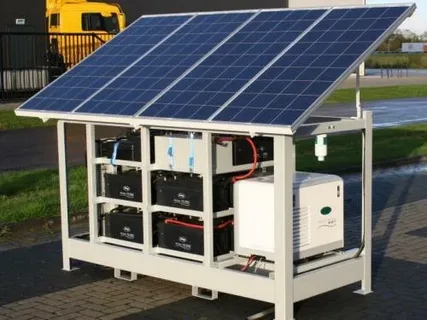Understanding the Impact of Stand Alone Off Grid Solar

As the world increasingly shifts towards sustainable energy solutions, Stand Alone Off Grid Solar is gaining traction among homeowners and businesses alike. Imagine harnessing the sun's power to generate your own electricity—independently and sustainably. These systems offer a practical way to reduce reliance on traditional power grids, providing not only energy security but also significant cost savings over time. Whether you're looking for complete independence from utility companies or simply want to embrace cleaner energy practices, understanding off-grid solar is essential.
What Are Off-Grid Solar Systems?
Off-grid solar systems are self-sufficient energy solutions designed for homes and businesses that want to break free from traditional power sources. Unlike grid-tied setups, these systems operate independently, generating electricity solely from sunlight. At the heart of an off-grid system is a solar panel array that captures sunlight during the day. This energy is then converted into usable electricity through inverters.
Energy storage plays a crucial role as well, often involving batteries that store excess power generated throughout the day. This stored energy can be used during nighttime or cloudy days when sunlight isn’t available. These systems are ideal for remote locations where extending electrical grids might be impractical or costly. They also provide peace of mind by ensuring a steady power supply regardless of external factors like utility outages or rising electricity prices.
How Do Off-Grid Solar Systems Work?
Off-grid solar systems operate independently from the traditional power grid. They harness sunlight through solar panels, which convert sunlight into electricity. This energy powers your home and can be used for various applications. Once generated, the electricity flows to an inverter. This device transforms direct current (DC) into alternating current (AC), making it usable for everyday appliances.
Additionally, off-grid systems include battery storage. These batteries store excess energy produced during sunny days for use at night or on cloudy days. A charge controller is also essential in this setup. It regulates the flow of energy to and from the batteries, preventing overcharging and extending battery life. This self-sufficient system allows users to generate clean energy anywhere, providing freedom from utility companies and reducing reliance on fossil fuels.
Advantages Of Stand Alone Solar
Stand Alone Solar offer remarkable independence from traditional power grids. This autonomy allows users to generate their own electricity, reducing reliance on utilities and providing greater control over energy consumption.
Energy Independence
Stand-alone solar systems provide complete energy independence, freeing you from reliance on the utility grid. This eliminates monthly electricity bills and insulates you from rising energy costs. You generate your own power, giving you control over your energy supply.
Remote Location Power
These systems are ideal for remote locations where grid connection is unavailable or prohibitively expensive. They provide a reliable power source for off-grid homes, cabins, farms, or businesses, opening up possibilities for living and working in isolated areas.
Environmental Benefits
Stand-alone solar utilizes clean, renewable solar energy, reducing your carbon footprint and dependence on fossil fuels. This contributes to a more sustainable energy future and helps mitigate the impacts of climate change.
Reliable Backup Power
With battery storage, stand-alone systems offer a reliable backup power source during grid outages or emergencies. This ensures essential appliances and lights continue to function, providing comfort and security when the grid is down.
Cost Savings and Return On Investment
Investing in off-grid solar systems can lead to significant cost savings over time. Once installed, these systems harness sunlight for energy, drastically reducing or even eliminating monthly electricity bills. The initial investment might seem daunting, but many homeowners find that the return on investment is worth it. By generating your own power, you become less reliant on fluctuating utility rates.
Additionally, various incentives and tax credits can further offset installation costs. These financial benefits make going off-grid more accessible than ever. Maintenance costs are also relatively low compared to traditional energy sources. With minimal moving parts and high durability, solar panels often last for decades with little upkeep required. When considering long-term expenses versus potential savings, the numbers frequently favor those who choose stand-alone solar solutions. The financial landscape is changing as renewable energy gains traction; seizing this opportunity could yield lasting rewards.
Environmental Benefits of Stand Alone Solar Power
Stand Alone Solar Power offer significant environmental benefits that resonate with eco-conscious individuals. By harnessing energy from the sun, these systems reduce reliance on fossil fuels, which are known for emitting greenhouse gases. Solar panels convert sunlight into electricity without producing harmful pollutants. This clean energy source contributes to improved air quality and reduces the carbon footprint of households and businesses alike.
In addition, off-grid solar installations promote biodiversity. They require less land compared to traditional power plants and have a smaller impact on ecosystems. Using renewable resources like solar minimizes water usage as well. Unlike conventional energy generation methods that consume vast amounts of water for cooling and processing, stand-alone systems operate independently without depleting vital water supplies. The shift towards off-grid solutions fosters sustainable practices while encouraging communities to embrace cleaner technologies. This transition nurtures a healthier planet for future generations.
Challenges And Limitations of Off-Grid Solar Systems
Off-grid solar systems come with their own set of challenges. One significant hurdle is the initial setup cost. While long-term savings can be substantial, the upfront investment may deter some homeowners. Weather variability also impacts performance. Cloudy days or prolonged rain can limit energy production, making it essential to have adequate battery storage for those gloomy periods. Space requirements pose another limitation. Solar panels need ample space for installation, which might not be feasible in urban settings where rooftops are limited.
Additionally, maintenance demands attention. Regular checks and potential repairs on batteries and panels require time and effort that some users may overlook. Technological advancements mean older systems may quickly become outdated. Keeping up with innovations necessitates ongoing investments in upgrades to ensure efficiency remains optimal over time.
Assessing Your Energy Needs for An Off Grid Stand Alone Solar Power System
Before investing in an Off Grid Stand Alone Solar Power System, it’s crucial to assess your energy needs accurately. Start by evaluating how much electricity you consume daily. This includes everything from lighting and appliances to heating and cooling. Create a list of all devices that will run on solar power. Note their wattage and the number of hours they operate each day.
Once you have this information, calculate the total energy requirements in kilowatt-hours (kWh). Consider seasonal variations as well; some months may require more energy due to increased usage or changes in weather conditions. This assessment not only helps in sizing your solar panels but also dictates battery storage capacity for times when sunlight is scarce. Tailoring your system to fit these exact demands ensures efficiency and reliability for your off-grid lifestyle.
Understanding Net Metering
Net metering is a critical concept for those considering off-grid solar systems. It allows homeowners to receive credits for excess energy generated by their solar panels. This system effectively turns your utility meter into a two-way device. When your solar panels produce more electricity than you consume, the surplus is sent back to the grid. The utility company then credits you based on this excess power. These credits can offset future electricity bills when your system isn’t producing enough energy, such as during cloudy days or at night.
Understanding net metering policies in your area is essential. Regulations vary widely from state to state and even among utility companies. Being informed helps maximize savings and optimize the performance of an off-grid setup. Engaging with local renewable energy organizations can provide insights into navigating these regulations effectively. Knowledge about net metering empowers users to make informed decisions that benefit their finances and sustainability goals.
Financing Options for Off-Grid Solar Systems
Financing an off-grid solar system can seem daunting, but there are several options to consider. Many homeowners explore personal loans as a straightforward way to fund their renewable energy projects. These loans often come with competitive interest rates. Another popular choice is leasing or power purchase agreements (PPAs). With these arrangements, you can install solar without upfront costs. Instead, you pay monthly for the energy generated.
Government incentives and tax credits also play a crucial role in reducing overall expenses. Research local programs that may provide rebates or subsidies for adopting green technology. Crowdfunding has emerged as a unique alternative too. Platforms dedicated to sustainable projects allow individuals to invest collectively in community-based solar initiatives. Credit unions and specialized financial institutions might offer tailored financing solutions with favorable terms for those looking to go off-grid. Always compare your options carefully before making decisions.
Maintenance And Power Up: Stand Alone Solar System
Maintaining your Stand Alone Solar System is crucial for optimal performance. Regular checks ensure efficiency and longevity. Start with the solar panels. Clean them periodically to remove dirt, dust, or debris that may block sunlight. A clean panel converts energy more effectively. Next, inspect the battery bank. Keep connections tight and terminals corrosion-free. This helps in maintaining a steady power supply.
Also, monitor your inverter regularly. It’s the heart of your system, converting stored energy into usable electricity for your home. Have a plan for seasonal adjustments. Some systems may need tweaks based on weather changes or increased energy demands during specific times of year. Being proactive about maintenance can prevent costly repairs down the line and keep your off-grid lifestyle running smoothly.
Conclusion
Stand Alone Off Grid Solar offer a unique solution for those seeking independence from traditional energy sources. They cater to diverse needs, from remote homesteads to eco-friendly lifestyles. The benefits extend beyond financial savings. Embracing off-grid technology contributes positively to the environment, reducing carbon footprints and promoting sustainability. While challenges exist, such as initial costs and maintenance requirements, many find these hurdles manageable with proper planning. Assessing individual energy needs is crucial for success in this endeavor.
FAQs
What is a Stand Alone Off Grid Solar?
A Stand Alone Off Grid Solar is designed to function independently from the traditional electrical grid. It harnesses energy from sunlight and stores it in batteries for later use. This setup allows users to generate their own power.
How much does an off-grid solar system cost?
The costs vary widely based on size, components, and installation services. On average, homeowners can expect to invest anywhere from $15,000 to $40,000 for a complete setup.
Do I need battery storage with an off-grid system?
Yes, battery storage is crucial for storing excess energy generated during sunny days for use when sunlight isn't available. Without proper storage solutions, you may face limitations during cloudy periods or at night.
Can I add more panels later if my needs change?
Absolutely! One of the advantages of most off-grid systems is scalability. If your energy demands grow over time or you want to enhance efficiency further, additional panels can be integrated into your existing setup seamlessly.
|
Related Business Listings |





